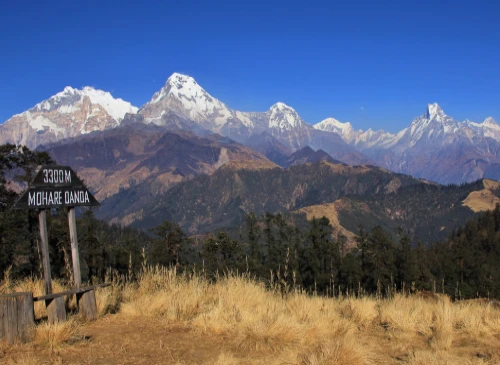The Annapurna Base Camp trek from Pokhara is surely one of the most exciting and picturesque trips to the Himalayas of Nepal. Starting from a picturesque ride from Pokhara to Nayapul, you are immediately in the middle of the greenery of the Nepalese countryside. The trek then passes through villages like Tikhedhunga and Ghorepani, where the culture of the Gurung and Magar ethnic groups is depicted. These villages will show part of the local people’s living environment and lay the background for the amazing trip to come.
An interesting feature of this trek is the sunset and sunrise view from Poon Hill, which presents an extensive view of the Annapurna and Dhaulagiri mountain ranges. It goes on further through several terrains, from subtropical forests and rice terraces to the alpine meadows and mountains. It adds more flavor to the trip not only to view and take in the awesome and stunning sceneries of Asia but also to make the trip interesting and full of challenges.
As trekkers move up towards the Base Camp, a beautiful view of some of the highest mountains in the world, including Annapurna and the Mountain of Fishtail, is seen. Even the base camp, located in the middle of the Annapurna massif, gives the most fantastic impressions of the surrounding mountains. During the walk, there is an opportunity to taste dishes in local tea houses, which can accommodate trekkers and offer delicious traditional dishes after the day of travel.
The ABC trek is not merely a hike, but rather it’s a spiritual journey to have a deeply enriched understanding of the nature and the culture of the region. The longevity of the sites and other cultural experiences, along with natural beauty and friendly people makes this trek an ideal example of a Himalayan trekking experience.
Why trek to Annapurna Base Camp from Pokhara?
The Annapurna Base Camp trek from Pokhara is one of the most rewarding Himalayan treks for a variety of reasons. First of all, the travel offers an impressive and varied scenic spectacle that consists of subtropical dense tropical plantations and cascade plantings, alpine pastures, and stiff and rebellious peaks of the mountains. This is helpful, as every day of the trek offers different beautiful views, making the experience forever and ever interesting and beautiful to the eyes. Commencing the journey from Pokhara, a beautiful city well-known for its Tourism destination surrounded by beautiful lakes makes the beginning of the journey unconventional.
It is very convenient and there is a lot of life in Pokhara that makes it the most appropriate starting point for the Annapurna Base Camp Trek. As a city, it offers different comforts such as accommodations, cuisines, attractions, and others that make it feasible for the trekkers to plan before and after the trek. The jeep ride from Pokhara to Nayapul, which is the beginning of the trek has beautiful scenery and helps to ease into the trek. Further, the geographical location of Pokhara in the shadow of the Himalayas is very picturesque, which offers a perfect view of the eagles that you will encounter while trekking.
Besides, the spectacular view of the Annapurna range can be enjoyed from Pokhara during the trek to Annapurna Base Camp, and instead of that, the trekkers have a great chance to embrace a wide cultural heritage. On the way, you come across typical Gurung and Magar settlements where you get a feel of the ethnic life to the hospitality of the people. The trek ends at Annapurna Base Camp located in the conservation area of the Annapurna Sanctuary, surrounded by the giants of the Himalayas. Such natural beauty accompanied by cultural attractions, along with factors like the convenience of the place, Pokhara, makes the Annapurna Base Camp Trek a worthwhile experience.
What to expect on the Annapurna Base Camp Trek from Pokhara
The ABC trek from Pokhara offers stunning views of the landscapes interlaced with cultural exposure. The views start right from the drive to Nayapul, where the trekking starts after you leave the beautiful city of Pokhara. The first few days lead you through such picturesque villages as Tikhedhunga and Ghorepani; you get to know the culture and tradition of the Gurung and Magar people. These cultural interactions, together with physical scenery and terraced fields, provided a perfect setting for the adventure.
And on going on, the main feature of the trek is Poon Hill, observing the sunrise. This is one of the most famous viewing points to watch the magnificent views of the Annapurna and Dhaulagiri ranges of the Himalayas early in the morning. It then starts climbing through the different vegetation zones from subtropical to alpine pastures, offering stunning impressive geographical faces. During the trekking process, you should walk through the rhododendron forests and mountains, and they make treks more splendid.
At the end of the Annapurna Base Camp trek, one gets to see high dramatic peaks, which include Annapurna and Machapuchare. Located at the basin of the Annapurna Sanctuary the base camp is quite beautiful and calm. The trek also entails staying in comfortable teahouses with good meals and warm food to boot. As with the Annapurna Base Camp Trek from Pokhara, this will be a cultural experience in addition to beautiful scenery and great satisfaction upon reaching the destination.
Best time for the Annapurna Base Camp Trek from Pokhara
The best season to take the Annapurna Base Camp Trek from Pokhara is during the pre- and post-monsoon periods. These are the best times regarding the weather and to get the best view of the Himalayas, if there are any.
Spring (March to May): This is one of the most favorite times to go for the Annapurna Base Camp Trek. As for the climate, it is normally warm with no rain; therefore, it is more preferred for trekking at this time of the year. They average from moderately warm to warm, and the land boasts of beautiful blossoming of rhododendrons and other types of wild flowers. It is a fully open site, which offers the spectacular sight of the Annapurna and Dhaulagiri mountains from nearby places. The other reason is that, unlike the autumn season, spring also provides a good climate for trekking, and it is not as busy as autumn.
Autumn (September to November): Autumn is another suitable time chosen to perform the trek. During the monsoon periods, and especially in the early morning after the rains are over, the sky is clear and clean with many benefits; you are likely to enjoy fresh cool air and much better views of the surrounding hills. Still, it is warm, but it is still good for trekking, and the trails, after the monsoon, are quite fine. This season is a bit busier than spring, as it comes with the beginning of the trekking season in Nepal. Since autumn is characterized by clear skies and little chance of big precipitation, trekking in this season is very enjoyable.
These two seasons provide the most favorable weather for trekking and stunning views for the Annapurna Base Camp Trek. But it is important to expect a change in the weather, as it often happens in the mountains. If you’re planning to do it in such a season, ensure that you make bookings on some accommodation and permits so that you get the right opportunity to experience the adventure.







